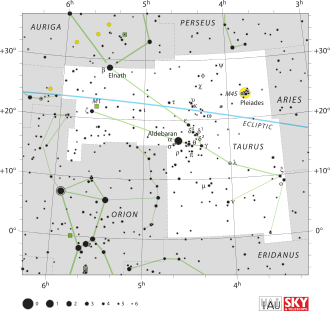Top Qs
Timeline
Chat
Perspective
HR 1099
Triple star system in the constellation Taurus From Wikipedia, the free encyclopedia
Remove ads
HR 1099 is a triple star system in the equatorial constellation of Taurus, positioned 11′ to the north of the star 10 Tauri.[16] This system has the variable star designation V711 Tauri, while HR 1099 is the star's identifier from the Bright Star Catalogue. It ranges in brightness from a combined apparent visual magnitude of 5.71 down to 5.94,[7] which is bright enough to be dimly visible to the naked eye. The distance to this system is 96.6 light years based on parallax measurements,[2] but it is drifting closer with a radial velocity of about −15 km/s.
This system was discovered to be a double star by F. G. W. Struve in 1822, with the components A and B having an angular separation of 5.4″. (The separation was measured at 6.7″ in 2016.)[17] R. E. Wilson in 1953 determined that the brighter member of this pair, component A, has a variable radial velocity. In 1963, O. C. Wilson noted that the same component shows very high emission cores in the calcium H and K absorption lines.[18] Follow-up observations by O. C. Wilson in 1964 showed that the hydrogen–α line of component A is fully in emission and it displays moderate broadening due to rotation. He found a stellar classification of K3 V for component B, matching an ordinary K-type main-sequence star.[19]

Observations during 1974–1975 demonstrated that component A is a spectroscopic binary star system of the RS Canum Venaticorum variable class. Given its average magnitude of around 5.9, it is one of the brighter known variables of this type.[21] No eclipses were observed, but an orbital period of 2.838 days was determined. Most of the emission was found to be coming from the more massive member of this pair.[22] Radio emission from the binary was detected by F. N. Owen in 1976.[23] It was shown to be a soft X-ray source in 1978 using the HEAO 1 satellite.[24]
This double-lined spectroscopic binary system consists of an evolving K-type subgiant and an ordinary G-type main sequence star. The two stars are orbiting so close to each other that their tidal effects are giving them an elliptical shape. The subgiant is filling about 80% of its Roche lobe.[6] The chromosphere of the subgiant is one of the most active known, with a deep convective zone powering the magnetic dynamo.[25][5] The G-type companion has a shallow convection zone and is less active.[6]
In 1980, significant variations were found in some spectral features related to surface temperature, suggesting the presence of starspots.[26] Doppler imaging confirmed these starspots are associated with the K subgiant. (It was the first cool star to have its surface Doppler imaged.[27]) The evidence suggests that the spots first appear at low latitude then migrated toward the poles.[21] These spots are much larger than they are on the Sun.[6] About 70% of all spots have been observed at latitudes higher than 50°, particularly around the polar region.[10][25] A polar spot has persisted for at least twenty years.[6]
The baseline apparent magnitudes of the two stars, after subtracting the effects of starspots, is 5.80 and 7.20.[6] Long term monitoring indicates the subgiant has two activity cycles, similar to the 11-year solar cycle. A 5.3±0.1 year cycle is associated with symmetrical flip-flopping of the spotted area between hemispheres. The longer 15–16 year cycle is a periodic variation in the total spot area. The global magnetic field of the star may be precessing with respect to the axis of rotation.[27]
Remove ads
See also
References
Further reading
Wikiwand - on
Seamless Wikipedia browsing. On steroids.
Remove ads

